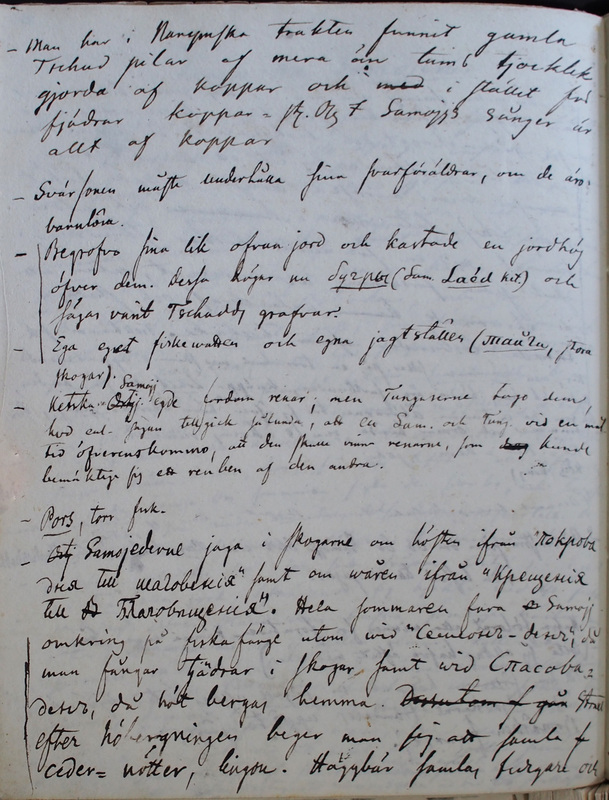Ethnographiska, historiska och statistiska anmärkningar. 228
Title
Ethnographiska, historiska och statistiska anmärkningar. 228
Description
| Man har i Narymska trakten funnit gamla Tschud pilar af mera än tum 6 tjocklek gjorda af koppar och med i stället för fjädrar koppar= etc. Obs. I Samojjs. sånger är allt af koppar. Svärsonen
måste underhålla sina svarföräldrar, om de äroAccording to Gemuev, Selkup families were based on brotherhood (Ru bratskaja semʹja), which means that a collective of brothers and fathers took care of the economy of the family. The norm in question concerns situations where an old couple, with no sons, would have been left to live alone when their daughter got married (Gemuev 1984).
barnlösa. Begrafva
sina lik ofvan jord och kastade en jordhögAccording to the ethnographic literature, the Selkups buried the deceased in a chest carved from cedar logs and they were buried under earth. Accordingly, this does not refer to Selkup graves, but another, possibly past community’s burial mounds. (Prokof’eva 1977)
öfver dem. Dessa högar nu бугры (Sam[ojedisk]. Laéd
Ket.) ochsägas varit Tschudds grafvar. Ega eget fiskewatten och egna jagtställen (тайга, stora skogar). Ketska Ostjj. Samojj. egde fordom renar,
men Tunguserne tago dem,There are traces of reindeer herding among the southern Selkups, including the kind of narration. However, researchers argue about the nature of reindeer herding among them. (Tučkova 2005: 327)
hvd [hvarvid] enl[igt]. sagan tillgick sålunda, att en Sam[ojed]. och Tung[us]. vid en mat tid öfverenskommo, att den skull vinna renarne, som kunde bemäktiga sig ett renben af den andra. Pors, torr fisk. Ostj. Samojederne jaga i skogarne om hösten ifrån покрова дня
Ru Pokrov denʹ or Pokrov Presvjatoj Bogorodinicy ʻIntercession of the Theotokos’ celebrated on 1.10 (14.10) and marking the turning of autumn into the winter. (Agapkina 2009: 127–128)
till шаговскiя samt om wåren ifrån "крещения till Благовещения"
Hela sommaren fare Samojj.Ru Kreščenʹe Gospodne ʻThe Baptism of Jesus’ celebrated on 6.1 (19.1), commemorating the baptism by John the Baptist. Ru Blagoveščenʹev denʹ. ʻThe Feast of the Annunciation’ celebrated on 25.3 (7.4), is one of the main feasts of Slavic Orthodox tradition. It is also related to the beginning of spring. (Vinogradova and Plotnikova 1999: 667–672; Tolstoj and Tolstaja 1995: 182–183)
omkring på fiskafänge utom wid "Семеновъ-день",
dåRu Semenov denʹ celebrated on 1.9 (14.9), commemorates Simeon Stylites and marks the beginning of the autumn period. (Agapkina and Belova 2009: 610–612)
man fånga tjädrar i skogar samt wid Спасова-день,
Ru Spasova denʹ ʻFeast of the Saviour’. Following the vernacular Russian calendar, there are three separate Feasts of the Saviour in August.
då höt bergas hemma. Dessutom af går Strax efter höbergningen beger man sig att samla седер=nötter, lingon. Häggbär samlas sed[n]are och |
Old Tschud arrows have been found in the Narym area. They are more than six inches thick, made of copper and instead of feathers copper [has been used] etc. NB: In Samoyed songs everything is made of copper. The son-in-law must take care of his parents-in-law, if they are childless. They bury their deceased on the earth and throw a mound of earth over them. These mounds [are called] now bugry (Samoyed Laéd Ket.) and are said to have been Tschuds’ graves.They own their fishing waters and hunting grounds (tajga, large forests). The Ket Samoyeds used to have reindeer but the Tungus took them away, and according to a narrative it happened because a Samoyed and a Tungus agreed over a meal that the one who could seize a reindeer bone from the other would win the reindeer. Pors, dry fish. The Samoyeds hunt in the forests in autumn from day of Pokrov to šagovskija and in the spring from [the day of] "Baptism to Annunciation". All through the summer the Samoyeds practise fishing, except during "day of Simeon" when they hunt capercaillies in the forests, and during day of the Saviour, when hay is stored at home. Immediately after haymaking they go to collect Siberian pine-nuts and lingonberries. Blackberries are gathered later and |

